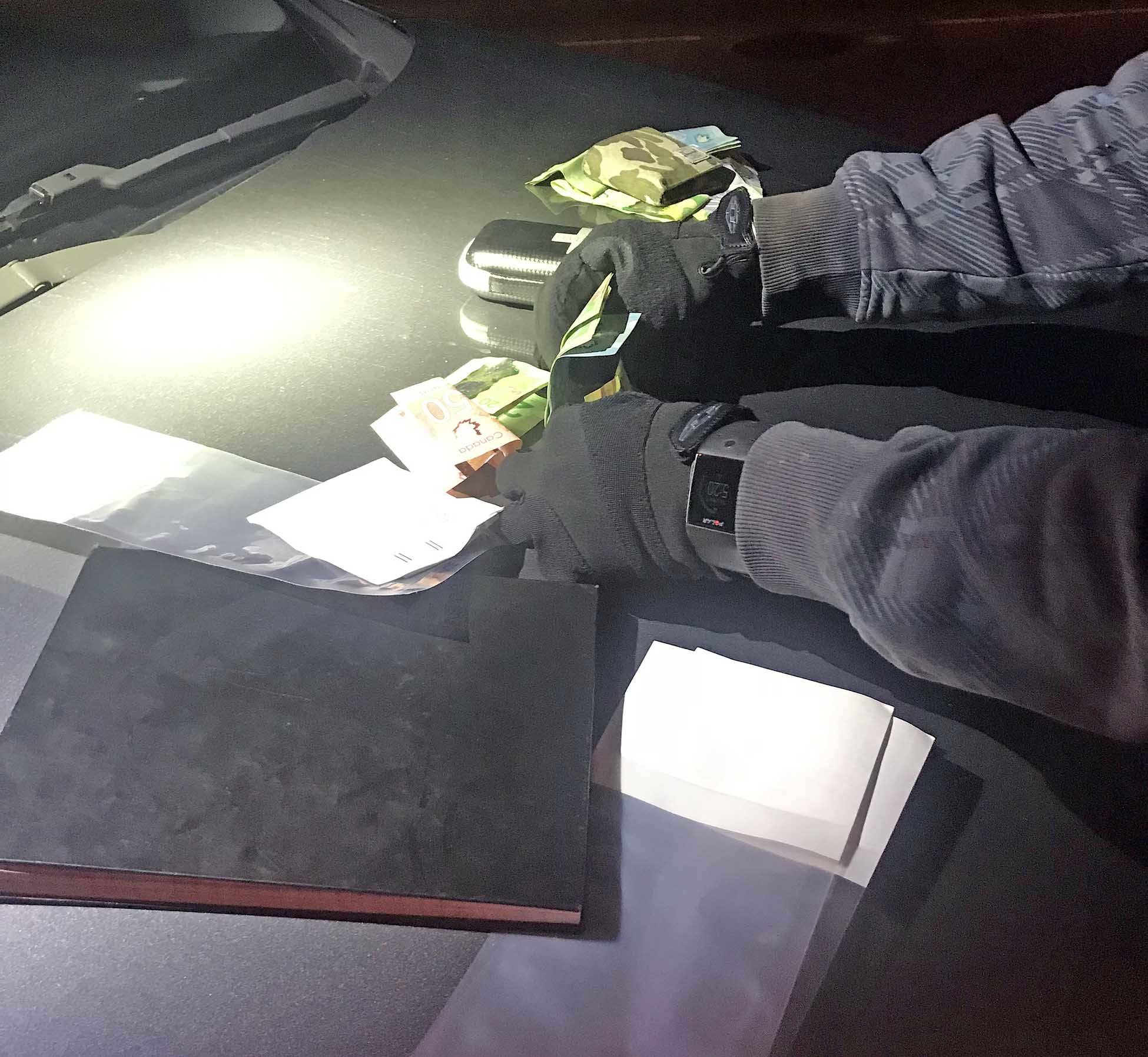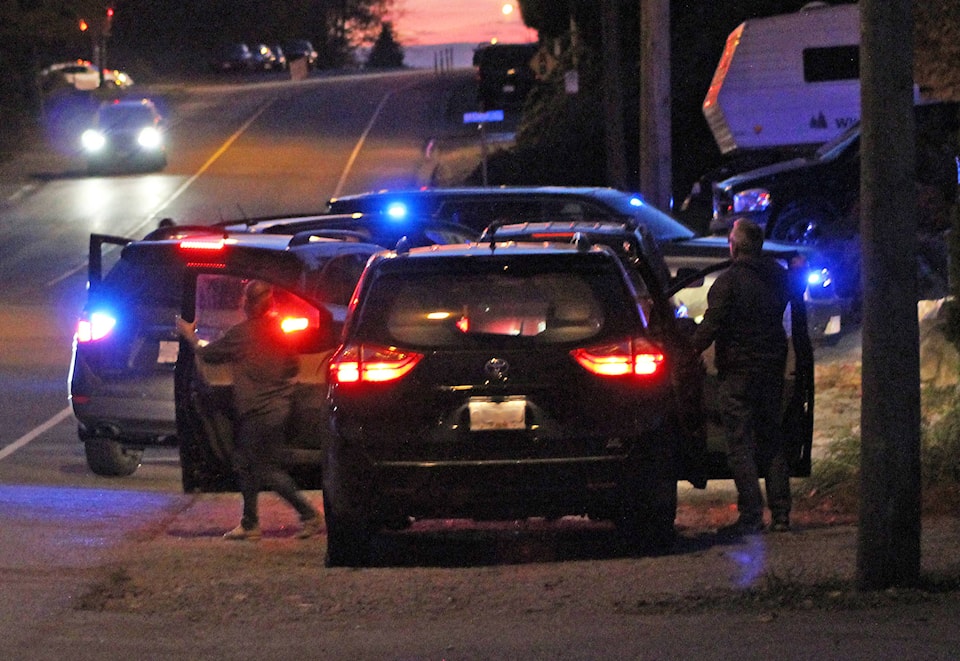Part Three in a five-part series on the inner workings of the Mission RCMP
Four unmarked police cars surround a vehicle on a rural Mission street. Acting quickly, officers order the suspect to get out of the car. He is detained without incident. The team of officers then begin the search process. One searches the suspect, placing his personal items on the hood of the police car.
Others begin searching the suspect’s vehicle, gathering evidence to strengthen the case. As suspected, some drug paraphernalia is discovered.
READ: Part One – A constant cycle of information
READ: Part Two – Sharing vital information
The Mission RCMP team has been watching the suspect for hours, observing and recording what they believe to have been several drug transactions. It’s all part of a surveillance mission in an attempt to learn more about a dial-a-dope operation in the community.
Tonight is considered a success.
* * *
Seven hours before the arrest, Corp. Jason Boon, head of the crime reduction unit, meets with his team in the basement of the Mission RCMP detachment. Earlier that week, they were updated at the Compstat (short for “computer statistics”) meeting about an ongoing dial-a-dope operation.
Today, the team will run a surveillance mission in hopes of collecting enough evidence to make an arrest.
While Boon can’t divulge how they know, the team has information that will allow them to locate the suspect, and they plan to follow him as he makes his rounds.
Nothing is left to chance.
The plan is to watch the suspect as he does hand-to-hand transactions, not once but several times.
“The objective will be to watch the dealer complete the transactions in person,” Boon explains.
Each member of the team is assigned a duty beforehand. Who makes the arrest, who searches the car, who records the information, it’s all planned ahead of time, with Boon acting as the quarterback, ensuring everyone does their jobs.
It may sound like a lot of work for a drug bust, but there is a bigger goal in mind.
Boon says the overall goal is to search a known drug house out of which police believe the dial-a-dope operation is operating. However, obtaining a search warrant can be difficult.
All of the observations made during surveillance will serve to satisfy a judge that a search of a residence is necessary.
Again, they need to establish a pattern.
With everyone understanding the mission and the overall goal, it’s time to hit the streets.
* * *
Wearing a bulletproof vest with the word “Observer” painted on the front in bright white letters doesn’t feel like the correct way to stay undercover, but Boon makes it clear that I can’t come along without it.
A black jacket and crossed arms help me to hide the fact that I’m wearing it as I sit in the passenger seat of the covert police car.
“I hope my driving doesn’t make you carsick,” jokes Boon as we prepare for surveillance.
I didn’t really get the joke until later that night.
Using the radio and only talking in short sentences, the team confirm they are all in position. The message is repeated each time to ensure no one has misheard.
The suspect’s car drives by and the surveillance begins.
The team employs a number of different strategies and techniques (which will not be divulged in this article) to gain the vantage points they need to witness any illegal behaviours. They receive specialized training and learn how to observe those committing crimes without being detected.
A voice on the radio announces the suspect has pulled over. A second vehicle parks close by. A person gets out and approaches the suspect. He leans into the passenger side window. About 10 seconds pass and he walks back to his car and drives away.
Deal done.
The police don’t follow the customer – they are focused solely on the seller, who has now pulled away and is back on the road. The surveillance continues.
This action, in various forms, is repeated. Sometimes at a side road, in a parking lot or other random locations. The buyers are both male and female and vary in age. All the transactions are watched and documented.
At one point during the surveillance, the suspect makes an unexpected turn and puts our vehicle out of position.
Boon immediately attempts to rectify the situation. Speeding up, making sudden sharp turns, passing cars, doubling back – and other maneuvers – get us back where we need to be.
Now I understand the carsick comment.
Fortunately Boon and his squad are trained to ensure no one gets hurt, or is put in danger, when the surveillance kicks into high gear.
“Officers on surveillance continuously conduct risk assessments based on the safety of the public. Often times they will risk losing a suspect or discontinue surveillance altogether if the risk to the public is high,” said Boon.
A few minutes pass and the suspect car turns into an apartment building and parks. Another person arrives, with a gas can, and fills his tank. Then the suspect drives off again.
As the light begins to fade and a final transaction takes place, the decision is made to pull the suspect over. As he drives in and out of streets in downtown Mission, the team loses sight of him.
The radio chatter intensifies, but there is no panic in anyone’s voice; more a sense of determination.
It doesn’t take long before somebody says, “I have eyes on him.”
The time for watching is over and the lead car fires up the lights and pulls the suspect over. The remaining cars all take their positions.
* * *
With the suspect in custody and officers continuing to search the vehicle, a quick look at his cellphone helps clear up the picture.
Text messages asking to meet up all appear to coincide with what the officers witnessed.
One message asks if, due to a shortage of money, a deal could be made using some cash and some gas – which explains the gas-can scenario earlier that day.
Oftentimes the buyers and sellers use slang for the drugs. “Hard” means cocaine, “down” is a depressant like heroin and “side” or “sideways” is meth.
Often, during an investigation, officers come in contact with buyers. When that occurs, police will ask the buyers if they want to kick their addictions and offer to help put them in contact with agencies that can assist them.
Once all the evidence has been collected and the operation comes to an end, Boon reminds me that all of this work is just “stage one of a larger investigation.”
He and the team plans to keep at it, no matter how long it takes to get results.
* * *
Several months after the initial investigation, no criminal charges were forwarded against the suspect.
The file was referred to the Civil Forfeiture Office and the vehicle, with a value of $5,000, was permanently seized.
Information obtained from the investigation also started a separate drug-trafficking investigation where a line worker was arrested and charged with possession for the purpose of trafficking.
Seven grams of fentanyl, $1,800 in cash and a $12,000 vehicle were seized. Officers are still trying to build a case to justify a search warrant for the drug house.
– NEXT WEEK:
General Duty

